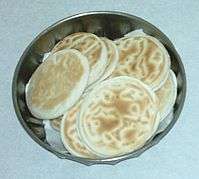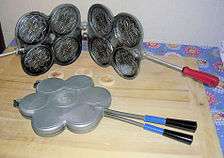Tigella
Crescentina, crescenta or tigella (plural: crescentine, crescenti or tigelle) is the name of a thin, 4-inch round shaped bread which originated from the Apennines in the Modena area (Emilia Romagna region, Northern Italy).

Crescentina been awarded PAT label (acronym for Traditional Agribusiness Product)[1] therefore the product has been included in the List of typical regional food – ingredients or processed products by Italian Ministry of Agriculture.
Tigelle are traditionally enjoyed filled in with the typical cunza, a spread made from pork lard and flavoured with garlic and rosemary, but cunza can be replaced with a choice of cold cuts, boar, rabbit, cheese, salty dressings or sweet spreads.
The term tigella derives from a latin word which means cover. Indeed tigella was originally the name of the terracotta disc in which the bread, called crescenta or crescentina, was cooked in by putting discs and the mixture of ingredients wrapped in chestnut leaves one upon the other in a pile in the fireplace not too near the flames. Afterwards the name tigella starts to be used for the bread itself, but is a mistake.

Nowadays crescenti are cooked in restaurants using electric griddles covered with suitable refractory material while at home a special aluminium shaped pan called tigelliera (plural: tigelliere) or ""cottole"" are mainly used over the gas cooker.
Crescentina as been usually experienced as traditional food at home or enjoyed in Apennines traditional restaurants, but in the last decade some fast food and fast casual retailers have introduced Crescenti as part of daily urban experience.
Crescentina is a typical local recipe which counts a lot of similiraties with other bread or quasi bread products derived from the rural tradition of the nearby areas. The best known among Crescenta-like items are piadina, borlengo, gnocco fritto and panigaccio; they all are made from flour, water, salt, yeast or bicarbonate, but in the last recipes they are added some grease like pork lard, cream or olive oil, Ingredients not present during the past in the Apennines. The main differences among these products are, on one hand, the texture of the starch-based batter they are prepared from and, on the other hand, the size. Crescenta and piadina differ from the others in batter texture since they are made from a less fluid batter; tigella differes from piadina in size since it is smaller: while one may have 1 piadina as a meal portion, one may have 4 or 5 tigellas instead.
Piadina, the flatbread from Romagna area (Rimini and Forlì-Cesena and Ravenna district), is thinner and larger.
Borlengo, originated from the Apennines around Modena and which is traditionally filled in with cunza too, is a thin salty pancake prepared from a flour and water batter and cooked in a hot large and flat frying pan; sometimes eggs are added to the batter.
Gnocco fritto, a widespread recipe all over the Emilia Romagna region, is mixed flour stripe fried in boiling oil, enjoyed in combination with ham or salami. In Bologna district gnocco fritto is also called crescentina.
Panigaccio, from the Lunigiana area (Apennines around Massa-Carrara in Tuscany), differes from Crescentina because yeast is not included among the ingredients of its recipe; besides panigaccio can be also cooked by boiling the fresh loaf in hot water instead of baking it in terracotta disc and served covered with tomato sauce or basil pesto.
The Italian painter Gino Covili painted an artwork called Le Crescenti in 1998. http://www.ginocovili.com/1998_3_lecrescenti.html
The writer Andrea Pini wrote the book called "" Tigella ti mangerò, come mangiare una tigella senza danneggiare la dentiera". In the local tradition se said "" chèrsent in t'al tigèli"" to reinforce the concept of difference between Tigella (the Cooking stone) and Crescentina (The bread).
See also
External links
- Modena cuisine typical products website (language: Italian)
- Modena Crescentina website (language: Italian)
- (Gino Covili: 'Le Crescenti')
References
- ↑ "Quattordicesima revisione dell'elenco nazionale dei prodotti agroalimentari tradizionali." (PDF). 5-6-2014. Check date values in:
|date=(help)